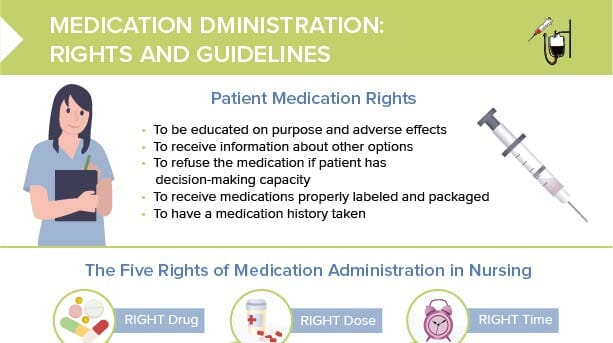What are the 5 rights of medication administration?
- Right drug: compare label to doctor’s order
- Right patient: identify using two identifiers
- Right dose: confirm appropriate dose
- Right route: correct method of administration (oral, IV, …)
- Right time: adhere to frequency as prescribed
What are patients’ medication rights?
Clients have the right to…
…be educated on purpose and adverse effects.
…receive information about other options.
…refuse the medication (if they have decision-making capacity).
…receive medications properly labeled and packaged.
…have a medication history taken.
Nursing tips for medication administration
- Make sure to be specific and thorough:
- When taking medication history, be sure to ask specifics about dosage, frequency, route of administration, prescriber, and duration of use.
- If medication order is unclear, contact the original prescriber before administering medication.
- Encourage cooperation and listen to your client:
- If a client declines a medication, inquire why and document statement from client.
- If a client has questions about a medication, explain possible therapeutic and adverse effects and purpose for administering this medication.
- Educate clients about alternative options and consequences of their choices.
6, 7, 8, 9 rights of medication administration – how many are there?
Over time, more “rights” have been added to the original 5 to enhance patient safety. Some sources add:
- Right documentation: confirms the nurse provided the medication as prescribed
- Right indication: narrows medication focus and reduces risk of incorrect prescription
- Right to refuse: client (if mentally capable) can refuse medication
- Right response: document before and after dosage results
Your specific institution or workplace might be using additional rights.
